While acoustic guitars have a great natural sound, adding some guitar effects can take your playing in interesting directions.
Plugging in a guitar effects pedal to your acoustic guitar can transform your instrument into something completely different.
In this guide, I will go through 8 guitar effects worth trying on acoustic guitar. For each effect, you can hear different examples of how the effect pedal can change the way you think of acoustic guitar.
The guitar effect pedals I cover in this guide are to be used purely as effects to take your tone in new directions.
There are some guitar pedals that can enhance your tone for live performances and give you better control of your sound.
If you’re looking for guitar pedals that can enhance your tone for live performances, check out this guide for 5 Essential Guitar Pedals for Acoustic Guitar.
Stereo Chorus Pedal
Chorus can sound amazing on acoustic guitar, but a stereo chorus takes your tone to a new level.
Chorus is a modulation effect and most modulation effects can be tastefully used with an acoustic guitar.
Here are two examples of a stereo chorus on an acoustic guitar (best listened to with headphones):
Note: if the video isn’t displaying above, please consider disabling your AdBlocker to support this site.You can hear that when the chorus pedal is applied to the acoustic guitar, it completely changes the vibe of the part. The guitar tone has an interesting shine to it that can help some parts stand out.
If you listen to the clip with headphones, you’ll instantly hear how the stereo chorus makes the guitar swell in size. You can see from the pedal settings in the video that you could easily reduce the intensity of the chorus for a subtle effect in the background, or crank it for a saturated tone.
I tend to use less chorus than what you hear in the video. I turned the chorus up so you can clearly hear it, so if you feel it is too overwhelming, you can easily turn it down on your own chorus pedal.
Here are some tips when using a chorus pedal on an acoustic guitar:
- Aim for subtlety: keep the mix low to avoid the chorus overwhelming your acoustic tone. Think of stereo chorus as a way of creating an atmospheric layer underneath your acoustic tone. While you can crank it up for some extreme effects, keeping the chorus subtle can sound amazing with an acoustic guitar.
- Run in stereo: if you’re hesitant about running a stereo rig, try it out before you dismiss it. Running stereo may require more cables and equipment, but the impact it can have on your sound is worth the effort.
- Match the speed and depth to each song: some songs will sound great with a slow and shallow chorus while other songs will work best with a fast and deep chorus. Learn to match the chorus settings to each song.
Best Stereo Chorus Pedal for Acoustic Guitar
A great stereo chorus pedal to check out is the MXR M134 Stereo Chorus:
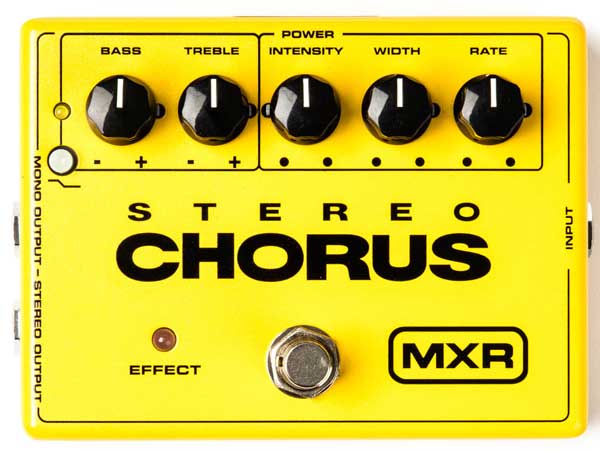
You control the chorus effect with three knobs: Intensity, Width, and Rate. You also have a Bass and Treble knob to adjust EQ and a Bass Filter button adjusts how chorus is applied to the bass frequencies.
This gives you plenty of control over your tone and the bass frequencies button is handy when applied on acoustic guitar to avoid your tone sounding muddy.
It’s worth mentioning that this pedal requires either 2x 9V batteries or an 18V power supply.
For some guitarists, the power requirements may be a bit of a hassle, so a great alternative is the TC Electronic Corona Chorus:
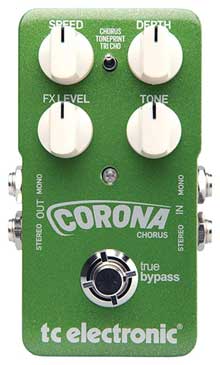
Unlike the MXR, this stereo chorus pedal is compact while still giving you a good range of control over the effect.
In addition to the four knobs, you can see a three-way toggle switch in the middle to choose between different chorus modes.
You can switch between Chorus, TonePrint, or Tri-Chorus modes. The TonePrint option allows you to create and customize your own chorus effect using TonePrint software.
This is a great feature if you really want to tweak the chorus to perfectly fit your acoustic guitar tone.
Learn more about chorus in my Ultimate Guide to Chorus Pedals here.
The guide includes the best chorus pedals including a couple of stereo chorus pedals.
Phaser Pedal
A phaser is a modulation effect and as mentioned above, modulation effects can sound amazing when applied properly to acoustic guitar.
Phaser pedals are popular with electric guitar thanks to the smooth swirling effect it creates. A phaser can sound just as good on acoustic guitar when used at the right times.
Here are two examples of how a phaser pedal sounds with an acoustic guitar:
In the first example, I changed my playing style to let the phaser shine. Instead of playing the typical strumming you hear in the song, by holding the chords you can hear the phaser’s thick and pulsating swirl. Adjusting your playing style to suit different effects is a great way to get the best results out of your gear.In the second example, you can hear how the phaser adds some atmosphere to the part without overwhelming it. Cranking the speed of the phaser can completely change the vibe of the part and can sound impressive when used at the right times.
Here are some tips when using a phaser pedal on an acoustic guitar:
- Experiment: a phaser can produce very different sounds depending on the settings. You can go from a subtle coloring to your tone to a full-on psychedelic experience. Test out the extremes of your phaser pedal and learn to apply a phaser tastefully to different songs.
- Match the speed to the song: some songs will sound best with a slow and swirling phaser, while others may benefit from fast pulsing. Think about the vibe you’re going for with each song and make sure the speed of the phaser matches that vibe.
- Try different pedal positions: if you use a number of different pedals, try placing your phaser pedal in different positions to hear how it reacts. Quite often, breaking the pedal order ‘rules’ gives you better results.
Best Phaser Pedal for Acoustic Guitar
A key point when using a phaser pedal on an acoustic guitar is to think about how much of the effect you want to hear. Do you want it to completely saturate your guitar tone or do you want it to sit in the background?
Being able to control the dry/wet mix is crucial to getting the most out of a phaser pedal. Unfortunately, a lot of phaser pedals don’t give you much control.
One of the most popular phaser pedals is the MXR Phase 90. As you can see from the below photo, the only control you have is speed:
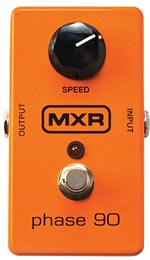
While this is a popular pedal for electric guitar, I don’t recommend it for acoustic guitar.
The lack of controls on the Phaser 90 will likely leave you frustrated. The lack of control is fine for electric guitar, but it becomes limiting when used on an acoustic guitar. Not being able to dial in the perfect phaser can completely ruin your sound.
If you buy a phaser pedal, make sure you get one with the ability to control the mix or level of the effect.
The two phaser pedals I recommend for acoustic guitar are the BOSS PH-3 Phase Shifter and the TC Electronic Helix Phaser:

Both of these pedals give you a fantastic level of control over the phaser. If I had to choose between the two, I would recommend the Helix due to the mix knob, TonePrint, and the stereo inputs and outputs.
For a closer look at these pedals and more options worth considering, check out my Ultimate Guide to Phasers.
Delay Pedal
Delay is one of the most popular guitar effects on electric guitar and it’s rare to see a pedalboard without a delay pedal.
Delay is also a great effect to use as an acoustic guitarist and can be used in a variety of ways.
Check out the below video for some basic examples of how you could use a delay pedal with an acoustic guitar:
The first example uses a stereo ping-pong delay that bounces back and forth between left and right. Use headphones to get the full effect. A ping-pong delay can sound amazing when used in a live performance as it makes your acoustic guitar sound huge. The delay can fill the room without distracting from what you’re playing.The second example uses an analog delay with a high mix so you can hear how it can warm up your tone. Usually, guitarists prefer turning the mix down, but in this example, I wanted to show how even a high mix can help create a lush layer on your tone and fill out your sound.
The third example uses a modulation delay to show how different delays can create different atmospheres and vibes. You can hear how the high feedback and the pitch effects completely change the guitar parts you hear. Many high-end delay pedals offer a wide range of delays like this one that combine delay with a range of different effects.
All three examples use the same guitar parts so you can hear how the delay can change the feel of what you hear. You can use a subtle delay to thicken up your tone, a lush delay to fill the room, or different atmospheric delays to create a different mood for different songs.
Here are some tips when using delay on an acoustic guitar:
- Run in stereo: if you run a stereo rig (highly recommended for acoustic guitar), try running a stereo delay. Hearing the delay bounce back and forth between the two speakers is a great way to add something interesting to your sound.
- Match the delay to your style of playing: if you’re playing a hard strumming song, a delay can quickly muddy up your sound. But when you’re playing soft parts, arpeggios, or sustaining chords, delay is a great way to build your tone up and fill it out.
- Match the tempo: many delay pedals have a tap tempo footswitch to match the delay timing to your playing. This is a great way to create a delay that fits with the rhythm you are playing. Alternatively, you can get a pedal that allows you to dial in the perfect delay time in milliseconds. Find out how to convert bpm to ms in this guide.
- Try different types of delay: many delay pedals will offer a range of different delay types. Experiment with different types and use them to fuel your creativity.
Delay is one of the most popular effects for a good reason, so if you don’t already have a delay pedal, it’s worth considering.
Best Delay Pedal for Acoustic Guitar
The right delay pedal for you depends on what types of delays you want to be able to use. Do you want to have multiple delay types and easily change back and forth between them? Or are you after a simple delay to thicken up your tone or create a background layer?
One of the most popular high-end delay pedals is the Strymon Timeline:
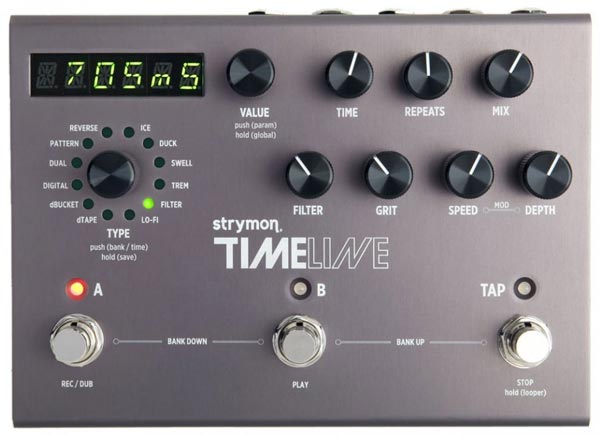
It’s an expensive pedal, but it packs in a lot of high-quality delay types and gives you precise control over the delay timing to the millisecond.
You can see from the far left knob that there are a lot of different delay types you can select, which suits guitarists looking at using delay to create atmospheric sounds or layers under their tone.
If you’re looking for something similar at a slightly lower price, check out the BOSS DD-500:
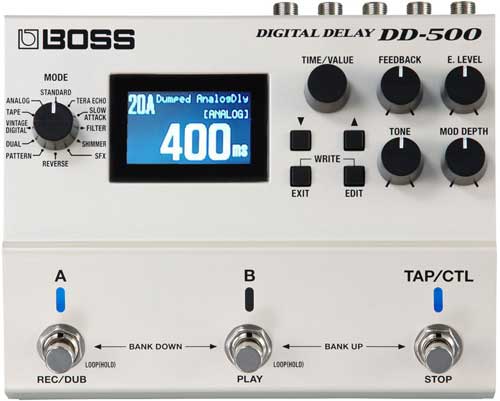
It’s pretty clear how similar these two pedals are based on the layout and features. If delay is a big part of your sound, then it’s worth spending the extra money for a fully-featured pedal like this one.
For everybody else who want to dabble with delay but don’t want to spend a lot on one, check out the TC Electronic Flashback 2:

It’s a compact pedal while still giving you access to a nice range of delay types. As you can see from the above photo, it’s a stereo pedal, so you can experiment with different stereo delays as you heard in the earlier examples.
If you want to learn more about delay, I’ve written a guide with a deep look at common delay features you may want to check out.
Learn more about delay pedals in my Ultimate Guide to Delay here. It includes a detailed look at different delay features and the best pedals available. The guide is handy if you’re not sure what you will need in a delay pedal.
Flanger Pedal
The first time I tried a flanger on my electric guitar, I hated it. Why on earth would I want my guitar to sound like a jet taking off?
Once I learned how to properly use the effect, it became obvious how useful flanger can be. The reason flanger isn’t as popular as other modulation effects like phaser or chorus is because everybody cranks it up when they first try one and can’t get over the metallic jet-like roaring sound. But when the intensity is dialed down, it sounds great.
A flanger is interesting on acoustic guitar because of the way it interacts with the extended frequencies you only get from an acoustic guitar. I personally love the sparkle it can give an acoustic tone.
Here are two examples of a flanger applied to both fingerpicking and strumming:
With a slow rate and balanced mix, you can hear how the flanger can be used without overpowering the original guitar tone.In the first example, the fingerpicking parts gain a crisp and shimmering quality that sounds similar to a subtle chorus pedal. If you were to increase the speed of the flanger, you would hear more warbling.
The second example shows that flanger can work well with strumming parts. I personally feel flanger sounds better than a phaser or chorus when used on strumming parts. Chorus can make strumming parts sound messy, while a subtle flanger can give the part an interesting color.
Here are some tips when using flanger on an acoustic guitar:
- Aim for subtle: you probably don’t want your acoustic guitar to sound like a jet taking off, so start with a subtle effect with a low mix and get a feel for a balance that suits your style
- Match the speed to the style: in the examples you can hear I used a very slow speed to match the slow fingerpicking. But if you’re playing something more energetic, a faster speed will help increase the energy
While flanger may not be as popular as other guitar effects, if you like the sound of the above examples, you may want to try one out for yourself.
Best Flanger Pedal for Acoustic Guitar
If you love the sound of a flanger and want to make it a key part of your sound, check out the EarthQuakerDevices Pyramids:

It should be obvious from the above photo that this pedal is a beast. The pedal can run in stereo, you can save presets and change between an impressive number of modes.
This type of pedal suits guitarists who want to dial in the perfect effect to match what you’re playing. Flanger is a great effect when it is used properly, so a pedal like this one is the best chance of dialing in the right settings to get the sound you want.
If you’re looking for something a bit simpler, check out the MXR M117R Flanger:

This pedal doesn’t run in stereo, but it still gives you a good amount of control over the effect.
Uni-Vibe Pedal
Uni-Vibe is an effect that is well-known among electric guitarists and most famous for giving Jimi Hendrix his psychedelic tone (find out about Jimi Hendrix’s gear and effects here).
While electric guitarists love to use Uni-Vibe to add some swirling modulation to their tones, it can also work well with an acoustic guitar in some cases.
Have a listen to the two examples below to hear Uni-Vibe on acoustic guitar:
In the first example, I used a slow Uni-Vibe to really give the held chords a slowly pulsating warble. You can hear how replacing the strummed chords with a single held chord helps bring out the best of the Uni-Vibe.In the second example, I turn the speed and intensity up to give the acoustic tone a watery feeling. This works well with fingerpicked parts and adjusting the speed to match any part is pretty simple.
If you feel the Uni-Vibe is overwhelming in the above examples, that’s because I turned the intensity up fairly high so you could clearly hear the effect it has. It’s easy to turn the intensity down and have a subtle effect that sounds similar to a chorus pedal.
While a lot of acoustic guitarists use a chorus pedal to add some character to their tone, not many use a Uni-Vibe pedal. The unique sound of Uni-Vibe is a great way to add something different to your tone and stand out.
Here are some tips when using Uni-Vibe on an acoustic guitar:
- Learn both modes: most Uni-Vibe pedals will allow you to switch between vibrato and chorus modes. While most guitarists tend to stick to the chorus mode, it’s worth spending time on both modes to learn how to use them. There may be times when you prefer the vibrato mode.
- Adjust your playing style: in the example, you can hear that I changed the way I played ‘Wish You Were Here’ to open up space for the Uni-Vibe to shine. If I didn’t change the way I played, the Uni-Vibe wouldn’t have worked as well as it did.
While Uni-Vibe may not be common, it is a great way to stand out and add some character to your tone.
Best Uni-Vibe Pedal for Acoustic Guitar
While the MXR M68 Uni-Vibe is possibly the most popular basic Uni-Vibe pedal, I recommend the TC Electronic Viscous Vibe:
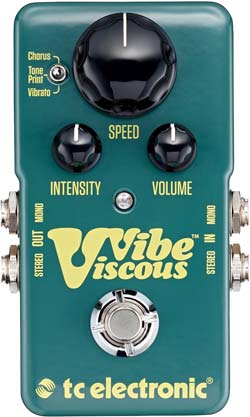
For the same price as the MXR M68, the Viscous Vibe gives you stereo input/output and the ability to customize your own preset via TonePrint.
You can read about the Viscous Vibe in my thorough review here.
There are a lot of other Uni-Vibe pedals with similar features at a wide range of prices, so to learn more about this effect and different options, check out my Ultimate Guide to Uni-Vibe here.
Octaver Pedal
An octave pedal (or an octaver) is a pitch-shifting pedal that can be used to create an octave above or below your tone and mix it together with your original tone.
Not many acoustic guitarists will have a use for an octaver, but I have seen quite a few solo acoustic guitarists using one to make it sound like a bass guitar.
Check out the below example for a simple way an octaver can be used with acoustic guitar:
In this example, a sub-octave signal is generated and mixed together with the original signal. When used in the right way, this can sound like a bass guitar playing along with your guitar parts.Some octave pedals allow you to create signals an octave above or even two octaves above or below your original signal. When used properly, these extra signals can make your acoustic guitar sound like a church organ.
The key to using an octave pedal with an acoustic guitar is to focus on single-note riffs and licks. Pitch shifting pedals work best when you play one note at a time although some can handle chords.
Doubling a riff like the above example with a bass-like sound can make a big difference in a live performance. I’ve seen it done well quite a few times by live performers.
You can even turn the original signal down and use the octave pedal to make your acoustic guitar sound like a bass guitar. One solo guitarist I watched live split his signal. One signal kept his original guitar signal and went straight to the mixing desk. The other signal passed through an octaver to create a sub-octave and was passed to a bass amp. The end result was a powerful sound all from one acoustic guitar.
Best Octaver Pedal for Acoustic Guitar
If you’re looking for a simple octave pedal to simulate a bass guitar, check out the EHX Nano POG (POG: Polyphonic Octave Generator):

The Nano POG takes the popular Micro POG and packs it into a tiny pedal. You can easily mix between your dry signal, an octave down, and an octave up. This can be used to simulate bass guitars or even 12-string guitars. While these generated signals won’t sound as realistic as a real bass guitar or a real 12-string guitar, they do work well.
If you’re looking for a bit more control so you can create organ-like sounds, check out the EHX POG2:
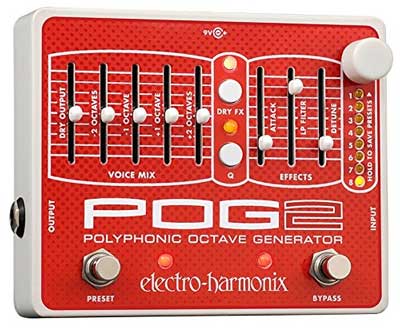
This is a beast of a pedal and a lot of fun to play with. It can seem intimidating at first, so if you get one, start out with everything turned to zero. Now turn up one slider from the ‘voice mix’ section at a time to learn what type of signal it generates.
Learn to combine different sliders to create chime sounds, organ sounds, or even ambient sounds. You can save presets on this pedal which is a great way to switch back and forth between settings during a live performance.
Reverb Pedal
The last effect I’ll cover in this guide is reverb. I consider reverb a must-have effect for acoustic guitar as I explain in this guide. In that guide, I talk about how to use reverb to enhance your acoustic tone.
In this guide, let’s look at how you can use reverb as an effect to dramatically change the atmosphere and quality of your acoustic guitar tone.
The below examples show what happens when you crank up different types of reverb on acoustic guitar:
Normally reverb sounds best when used in subtle ways to enhance your tone. But in the above examples, you can hear that using reverb as an effect can be a great way to completely change the vibe.The first example uses an ambient reverb on a shimmer setting that works almost like a sustain pedal that creates a lush and layered background behind the guitar. You can still clearly hear the original guitar tone and the ambient reverb sits in the background. This works well for sustained chords and fingerpicking instead of aggressive strumming.
The second example uses a stereo reverb and shows how a stereo signal can give your guitar tone a wide and surrounding feeling. You will notice how different it sounds compared to the original tone. Turning the mix down will bring the original tone back to center, while cranking it up will further spread the tone out in a wide stereo field.
There are so many different types of ambient or atmospheric reverbs you could use and the two above examples only gives you a glimpse of what is possible.
Best Reverb Pedal for Acoustic Guitar
If you’re looking for a simple reverb pedal, check out my Guide to Essential Guitar Effects for Acoustic Guitar. In that guide, I talk about basic reverb pedals that work well with an acoustic guitar.
A great full-featured reverb pedal with an impressive range of reverb types I recommend checking out is the Eventide Space Reverb:
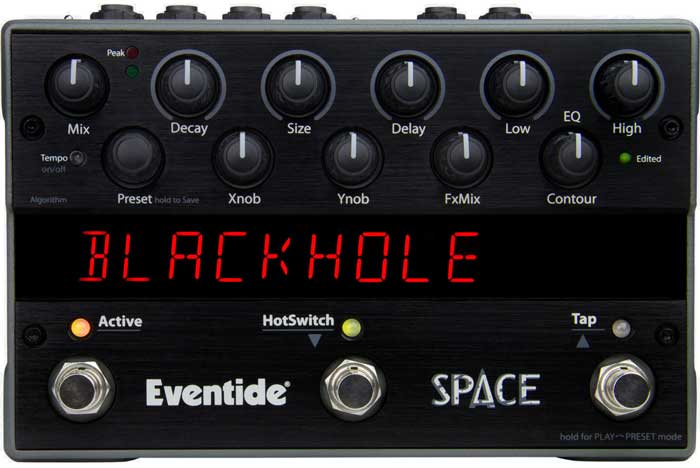
You can dial in standard reverb types as well as some really interesting combination effects to create lush atmospheric layers.
If you’re looking for something a little bit different and want to expand the range of reverb effects you can use in combination with other interesting effects, check out the Eventide H9:

This isn’t quite a reverb pedal, but the effects it produces is perfect if you’re looking for the ambient and atmospheric effects you can get out of reverb pedals. The H9 includes reverb algorithms found in the Eventide Space, along with a range of different types of effects.
If you like the idea of digging into different combinations of unique effects, I recommend checking out the H9.
The Eventide H9 is a bit confusing at first (the different models are based on how many algorithms come with the pedal), so read through my review of the H9 here to learn what it is and how to use it.
Learn More About Guitar Effects
If you like the idea of using guitar effects with your acoustic guitar, it’s worth spending some time learning about the different types of effects and how each type works.
In my Guitar Effects Course, you can hear examples of all types of guitar effects, how they work, how to combine them with other effects, and more. The goal of the course is to develop your understanding of guitar effects as well as build your ear so you can identify and dial in the perfect effects for any situation.
The course covers all of the above effects in detail as well as every other effect you may want to use on acoustic or electric guitar. While the course uses electric guitars in the audio examples, the lessons are still relevant to acoustic guitarists.
Check out my Guitar Effects Course here to find out more and get started.
Thank you to everybody who purchases the course as it helps support Guitar Gear Finder and gives me time to write guides like this one.
